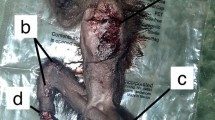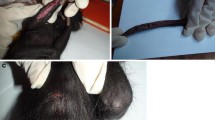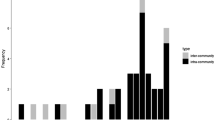Abstract
Infanticide has been observed across many primate taxa, but the extent of its occurrence is not fully understood due to difficulty in observation and uneven reporting. Several hypotheses have been proposed to explain why infanticide occurs in primates and whether it benefits some individuals within a social group. Here we report on a case of infanticide, followed by partial consumption of the infant, in a population of Coquerel’s sifaka (Propithecus coquereli) at Mariarano, Northwest Madagascar. We witnessed an adult male sifaka kill and consume part of an infant, a member of his own social group, as well as the mother’s reaction to the infanticide. Following the infanticide, the mother of the deceased infant left the social group after repeated agonistic encounters with the other group members. We evaluate how this event relates to the predictions of four common hypotheses. Further research on Coquerel’s sifaka is needed to determine the frequency of infanticide in this species, and in lemurs more generally, because infanticide is currently poorly understood in this taxon.
Similar content being viewed by others
References
Agoramoorthy G, Rudran R (1995) Infanticide by adult and subadult males in free-ranging red howler monkeys, Alouatta seniculus, in Venezuela. Ethology 99(1–2):75–88
Altmann J (1974) Observational study of behavior: sampling methods. Behaviour 49:227–267
Alvarez S, Di Fiore A, Champion J, Pavelka MS, Páez J, Link A (2015) Male-directed infanticide in spider monkeys (Ateles spp.). Primates 56(2):173–181
Andrews J (1998) Infanticide by a female black lemur, Eulemur macaco, in disturbed habitat on Nosy Be, North-Western Madagascar. Folia Primatol 1998(69):14–17
Bezerra BM, Souto ADS, Schiel N (2007) Infanticide and cannibalism in a free-ranging plurally breeding group of common marmosets (Callithrix Jacchus). Am J Primatol 69:945–952
Borries C (1997) Infanticide in seasonally breeding multimale groups of Hanuman langurs (Presbytis entellus) in Ramnagar (South Nepal). Behav Ecol Sociobiol 41:139–150
Borries C, Launhardt K, Epplen C, Epplen JT, Winkler P (1999) Males as infant protectors in Hanuman langurs (Presbytis entellus) living in multimale groups–defence pattern, paternity and sexual behaviour. Behav Ecol Sociobiol 46:350–356
Charpentier MJE, Drea CM (2013) Victims of infanticide and conspecific bite wounding in a female-dominant primate: a long-term study. PLoS ONE 8(12):e82830
Culot L, Lledo-Ferrer Y, Hoelscher O, Muñoz Lazo FJJ, Huynen M-C, Heymann EW (2011) Reproductive failure, possible maternal infanticide, and cannibalism in wild moustached tamarins, Saguinus mystax. Primates 52:179–186
Curtin R, Dolhinow P (1978) Primate social behavior in a changing world. Am Sci 66(4):468–475
Deschner T, Heistermann M, Hodges K, Boesch C (2004) Female sexual swelling size, timing of ovulation, and male behaviour in wild west African chimpanzees. Horm Behav 46:204–215
Digby L (1995) Infant care, infanticide, and female reproductive strategies in polygynous groups of common marmosets (Callithrix jacchus). Behav Ecol Sociobiol 37:51–61
Digby L, Saltzman W (2009) Balancing cooperation and competition in callitrichid primates: examining the relative risk of infanticide across species. In: Ford SM, Porter LM, Davis LC (eds) The smallest anthropoids: the marmoset/callimico radiation. Springer, US, pp 135–153
Dixson AF (2012) Primate sexuality: comparative studies of the prosimians, monkeys, apes, and humans, 2nd edn. Oxford Univ Press, Oxford
Erhart EM, Overdorff DJ (1998) Infanticide in Propithecus diadema edwardsi: an evaluation of the sexual selection hypothesis. Int J Primatol 19:73–81
Fairbanks LA, McGuire MT (1987) Mother- infant relationships in vervet monkeys: response to new adult males. Int J Primatol 8:351–366
Hausfater G (1984) Infanticide: comparative and evolutionary perspectives. Curr Anthropol 25:500–502
Hausfater G, Hrdy SB (1984) Infanticide: comparative and evolutionary perspectives. Aldine, New York
Heistermann M, Ziegler TE, van Schaik CP, Launhardt K, Winkler P, Hodges JK (2001) Loss of oestrus, concealed ovulation and paternity confusion in free-ranging Hanuman langurs. Proc R Soc Lond Ser B Biol Sci 268:2445–2451
Hood LC (1994) Infanticide among ringtailed lemurs (Lemur catta) at Berenty Reserve, Madagascar. Am J Primatol 33:65–69
Hrdy SB (1974) Male-male competition and infanticide among the langurs (P. entellus) of Abu, Rajasthan. Folia Primatol 22:19–58
Hrdy SB (1979) Infanticide among animals: a review, classification, and examination of the implications for the reproductive strategies of females. Ethol Sociobiol 1:13–40
Hrdy SB (2016) Variable postpartum responsiveness among humans and other primates with “cooperative breeding”: a comparative and evolutionary perspective. Horm Behav 77:272–283
Ichino S (2005) Attacks on a wild infant ring-tailed lemur (Lemur catta) by immigrant males at Berenty, Madagascar: interpreting infanticide by males. Am J Primatol 67:267–272
Irwin MT, Wright PC, Birkinshaw C, Fisher B, Gardner CJ, Glos J, Goodman SM, Loiselle P, Rabeson P, Raharison JL, Raherilalao MJ, Rakotondravony D, Raselimanana A, Ratsimbazafy J, Sparks J, Wilmé L, Ganzhorn JU (2010) Patterns of species change in anthropogenically disturbed forests of Madagascar. Biol Cons 143:2351–2362
Jolly A, Caless S, Cavigelli S, Gould L, Pereira ME, Pitts A, Pride RE, Rabenandrasana HD, Walker JD, Zafison T (2000) Infant killing, wounding and predation in Eulemur and Lemur. Int J Primatol 21:21–40
Kittler K, Dietzel S (2016) Female infanticide and female-directed lethal targeted aggression in a group of ring-tailed lemurs (Lemur catta). Primate Biol 3:41–46
Lewis RJ, Razafindrasamba SM, Tolojanahary JP (2003) Observed infanticide in a seasonal breeding prosimian (Propithecus verreauxi verreauxi) in Kirindy Forest, Madagascar. Folia Primatol 74:101–103
Littlefield BL (2010) Infanticide following male takeover event in Verreaux’s sifaka (Propithecus verreauxi verreauxi). Primates 51:83
MacIntosh AJ, Sicotte P (2009) Vigilance in ursine black and white colobus monkeys (Colobus vellerosus): an examination of the effects of conspecific threat and predation. Am J Primatol 71:919–927
McGoogan KC (2011) Edge effects on the behaviour and ecology of Propithecus coquereli in Northwestern Madagascar. PhD thesis, University of Toronto.
Melo L, Mendes Pontes AR, Monteiro da Cruz MAO (2003) Infanticide and cannibalism in wild common marmosets. Folia Primatol 74:48–50
Morelli T, King S, Pochron S, Wright P (2009) The rules of disengagement: takeovers, infanticide, and dispersal in a rainforest lemur, Propithecus edwardsi. Behaviour 146(4/5):499–523
Palombit RA (2015) Infanticide as sexual conflict: coevolution of male strategies and female counterstrategies. Cold Spring Harbor Perspect Biol 7:a017640
Palombit RA, Seyfarth RM, Cheney DL (1997) The adaptive value of friendships to female baboons: experimental and observational evidence. Anim Behav 54:599–614
Palombit RA (2012) Infanticide: Male strategies and female counterstrategies. In: Mitani JC, et al. (eds) The evolution of primate societies. University of Chicago Press, Chicago, pp 432–468
Pazol K (2003) Mating in the Kakamega forest blue monkeys (Cercopithecus mitis): does female sexual behaviour function to manipulate paternity assessment? Behaviour 140:473–499
Pereira ME, McGlynn CA (1997) Special relationships instead of female dominance for redfronted lemurs, Eulemur fulvus rufus. Am J Primatol 43:239–258
Pereira ME, Weiss ML (1991) Female mate choice, male migration, and the threat of infanticide in ringtailed lemurs. Behav Ecol Sociobiol 28:141–152
Ramsay MS, Teichroeb JA (2019) Anecdotes in primatology: temporal trends, anthropocentrism, and hierarchies of knowledge. Am Anthropol 121:680–693
Rasoloharijaona S, Randrianambinina B, Braune P, Zimmermann E (2006) Loud calling, spacing, and cohesiveness in a nocturnal primate, the Milne Edwards' sportive lemur (Lepilemur edwardsi). Am J Phys Anthrolopol 129:591–600
Rees A (2009) The infanticide controversy: primatology and the art of field science. The University of Chicago Press, Chicago
Richard AF (2003) Propithecus, Sifakas. In: Goodman SM, Stead JP (eds) The natural history of Madagascar. University of Chicago Press, Chicago, pp 1345–1348
Rimbach R, Pardo-Martinez A, Montes-Rojas A, Fiore AD, Link A (2012) Interspecific infanticide and infant-directed aggression by Spider Monkeys (Ateles hybridus) in a fragmented forest in Colombia. Am J Primatol 74:990–997
Roberts EK, Lu A, Bergman TJ, Beehner JC (2012) A Bruce effect in wild geladas. Science 335:1222–1225
Rudran R (1973) The reproductive cycles of two subspecies of purple-faced langurs (Presbytis senex) with relation to environmental factors. Folia Primatol 19(1):41–60
Salmona J, Jan F, Rasolondraibe E, Besolo A, Ousseni D, Beck A, Zaranaina R, Rakotoarisoa H, Rabarivola C, Chikhi L (2014) Extensive survey of the endangered Coquerel’s sifaka Propithecus coquereli. Endanger Species Res 25:175–183
Teichroeb JA, Sicotte P (2008) Infanticide in ursine colobus monkeys (Colobus vellerosus) in Ghana: new cases and a test of the existing hypotheses. Behaviour 145:727–755
Townsend SW, Slocombe KE, Thompson ME, Zuberbühler K (2007) Female-led infanticide in wild chimpanzees. Curr Biol 17:R355–R356
Treves A, Drescher A, Snowdon CT (2003) Maternal watchfulness in black howler monkeys (Alouatta pigra). Ethology 109:135–146
van Schaik CP (2000) Infanticide by male primates: the sexual selection hypothesis revisited. In: van Schaik CP, Janson CH (eds) Infanticide by males and its implications. Cambridge University Press, Cambridge, pp 27–60
Van Schaik CP, Kappeler PM (1997) Infanticide risk and the evolution of male–female association in primates. Proc R Soc Lond Ser B 264:1687–1694
Vieilledent G, Grinand C, Rakotomalala FA, Ranaivosoa R, Rakotoarijaona J-R, Allnutt TF, Achard F (2018) Combining global tree cover loss data with historical national forest cover maps to look at six decades of deforestation and forest fragmentation in Madagascar. Biol Cons 222:189–197
Wright PC (1995) Demography and life history of free-ranging Propithecus diadema edwardsi in Ranomafana National Park, Madagascar. Int J Primatol 16:835
Wright PC (1999) Lemur traits and Madagascar ecology: coping with an island environment. Am J Phys Anthropol 110:31–72
Xiang Z, Grueter CC (2007) First direct evidence of infanticide and cannibalism in wild snub-nosed monkeys (Rhinopithecus bieti). Am J Primatol 69:249–254
Yao H, Yu H, Yang B, Yang W, Xu H, Grueter CC, Li M, Xiang Z (2016) Male infanticide in the golden Snub-Nosed Monkey (Rhinopithecus roxellana), a seasonally breeding primate. Int J Primatol 37:175–184
Zhao Q, Borries C, Pan W (2011) Male takeover, infanticide, and female countertactics in white-headed leaf monkeys (Trachypithecus leucocephalus). Behav Ecol Sociobiol 65:1535–1547
Zimmermann E, Cepok S, Rakotoarison N, Zietemann V, Radespiel U (1998) Sympatric mouse lemurs in north-west Madagascar: a new rufous mouse lemur species (Microcebus ravelobensis). Folia Primatol 69:106–114
Zinner D, Deschner T (2000) Sexual swellings in female hamadryas baboons after male take-overs: “deceptive” swellings as possible female counter-strategy against infanticide. Am J Primatol 52:157–168
Acknowledgements
We are grateful to Eleanor Field, Heather Gilbert, Sarah Hayes, and all the staff of Operation Wallacea Madagascar, Development and Biodiversity Conservation Action for Madagascar, and the Vondron’Olona Ifotony Mariarano for logistical support. Miarisoa Ramilison, Onja Razafindramasy, Devon Block-Funkhouser, and Richmond Aririguzoh provided assistance in data collection.
Author information
Authors and Affiliations
Corresponding author
Additional information
Publisher's Note
Springer Nature remains neutral with regard to jurisdictional claims in published maps and institutional affiliations.
Electronic supplementary material
Below is the link to the electronic supplementary material.

10329_2020_828_MOESM1_ESM.jpg
Supplementary Figure 1. Infant sifaka retrieved after the mother had left. Injuries can be seen on various points of the body and were all inflicted by the infanticidal male (JPG 8957 kb)
About this article
Cite this article
Ramsay, M.S., Morrison, B. & Stead, S.M. Infanticide and partial cannibalism in free-ranging Coquerel’s sifaka (Propithecus coquereli). Primates 61, 575–581 (2020). https://doi.org/10.1007/s10329-020-00828-z
Received:
Accepted:
Published:
Issue Date:
DOI: https://doi.org/10.1007/s10329-020-00828-z




